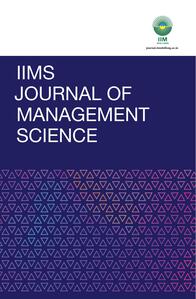
1Westminster International University, Tashkent, Uzbekistan
2School of Management, Presidency University, Bengaluru, Karnataka, India
Creative Commons Non Commercial CC BY-NC: This article is distributed under the terms of the Creative Commons Attribution-NonCommercial 4.0 License (http://www.creativecommons.org/licenses/by-nc/4.0/) which permits non-Commercial use, reproduction and distribution of the work without further permission provided the original work is attributed.
Several studies have been conducted to establish the relationships of different factors associated with the e-wallet usage in the recent times. But the effect of COVID-19 pandemic has impacted the e-wallet usage in transformed perspectives. In the crisis period, the acceptance of technology by the customers has definitely brought in the various dimensions to the business stakeholders to leverage on the benefits. It is very much evident for organizations to rework on their strategic viewpoints based on the trends and changes. The pandemic has brought in diverse experiences for the customers as well as businesses. The purpose of this research article leads to ascertaining the frugal consumers by analyzing their buying behavior and to further test the conceptual model of the impact of e-wallets on their buying behavior. This study uses the technology acceptance model (TAM) involving variables such as “Perceived Usefulness,” “Perceived Ease of Use,” “Perceived Risk,” “Trust,” “Social Influence,” “Promotional Benefits,” “Attitude,” “Behavior Intention to Buy Using E-wallets,” and the “Actual Usage of E-wallets.” Findings of this study portray the frugality of the consumers by the nature of their buying behavior, and they also show a strong relation between the frugal consumers and the positive or negative influence of e-wallets on their buying behavior. The results of the study can be applied by concerned organizations to improve their business model with respect to the variables mentioned.
Perceived usefulness, frugality, ease of use, usage rate, promotional benefits, behavioral intention
Aji, H. M., Berakon, I., & Husin, M. M. (2020). COVID-19 and e-wallet usage intention: A multigroup analysis between Indonesia and Malaysia. Cogent Business & Management, 7(1), 1804181.
Bhagyashri, R., & Pachpande, A. A. (2018). Study of e-wallet awareness and its usage in Mumbai. Journal of Commerce & Management Thought, 9(1), 33–45.
Co?kun, A., & Yetkin Özbük, R. M. (2019). Environmental segmentation: Young millennials’ profile in an emerging economy. Young Consumers, 20(4), 359–379.
Dehkordi, G. J., Rezvani, S., Rahman, M. S., Fouladivanda, F., & Jouya, S. F. (2012). A conceptual study on e-marketing and its operation on firm’s promotion and understanding customer’s response. International Journal of Business and Management, 7(19). https://ccsenet.org/journal/index.php/ijbm/article/view/17362
Doan, N. (2014). Consumer adoption in mobile wallet: A study of consumers in Finland. Turku University of Applied Sciences.
Kumar, N. (2016). Growth drivers and trends of e-wallets in India. Manthan: Journal of Commerce and Management, 3(1), 65–72.
Kurniawan, B., Wahyuni, S. F., & Valentina, T. (2019) The influence of digital payments on public spending patterns. Journal of Physics: Conference Series, 1402(6), 066085.
Kustono, A. S., Nanggala, A. Y. A., & Mas’ud, I. (2020). Determinants of the use of e-wallet for transaction payment among college students. Journal of Economics Business & Accountancy Ventura, 23(1), 85–95.
Lawson, S. T. (2003). Towards an understanding of frugal consumers. Australasian Marketing Journal (AMJ), 11(3), 8–18.
Madan, K., & Yadav, R. (2016). Behavioural intention to adopt mobile wallet: A developing country perspective. Journal of Indian Business Research, 8(3), 227–244.
Malik, A. Suresh, S., & Sharma, S. (2019). An empirical study of factors influencing consumers attitude towards adoption of Wallet Apps. International Journal of Management Practice, 12(4), 426–442.
Nag, K. A., & Gilitwala, B. (2019). E-wallet-factors affecting its intention to use. International Journal of Recent Technology and Engineering. International Journal of Recent Technology and Engineering (IJRTE), 8(4). https://doi.org/10.35940/ijrte.D6756.118419
Orhun, A. Y. (2016). Frugality is hard to afford. Journal of Marketing Research, 56(1), 1–17.
Pan, L. (Sunny), Pezzuti, T., Lu, W., & Pechmann, C. (Connie). (2019). Hyperopia and frugality: Different motivational drivers and yet similar effects on consumer spending. Journal of Business Research, 95(C), 347–356.
Rani, P. (2014). Factors influencing consumer behaviour. International Journal of Current Research and Academic Review, 2(9), 52–61.
Rathore, D. H. (2016). Adoption of digital wallet by consumers. BVIMSR’s Journal of Management Research, 8(1). https://bvimsr.org/wp-content/uploads/2020/04/10.-Dr-Hem-Shweta-Rathore.pdf
Shaw, N. (2014). The mediating influence of trust in the adoption of the mobile wallet. Journal of Retailing and Consumer Services, 21(4), 449–459.
Shin, D.-H. (2019). Towards an understanding of the consumer acceptance of mobile wallet. Computers in Human Behavior, 25(6), 1343–1354.
Sivakavitha, S., & Bhuvaneswari, D. (2017). An intellectual study on preference towards the usage of electronic wallets among urban population of Chennai city. Imperial Journal of Interdisciplinary Research, 3(9), 894–898.
Slade, E., Dwivedi, Y. K., Piercy, N. C., & Williams, M. D. (2015). Modeling consumers’ adoption intentions of remote mobile payments in the UK. Psychology and Marketing, 32(8), 860–873.
Todd, S., & Lawson, R. (2003). Towards an understanding of frugal consumers. Australasian Marketing Journal, 11(3), 8–18.
Trivedi, J. (2016). Factors determining the acceptance of e-wallets. International Journal of Applied Marketing and Management, 1(2), 42–53.
Yadav, M. P., & Arora, M. (2018). A study on impact on customer satisfaction for e-wallet using path analysis model. Innovation Finance & Accounting. https://events.rdias.ac.in/wp-content/uploads/2021/06/6.-A-Study-on-Impact-on-Customer-Satisfaction-for-E-Wallet-Using-Path-Analysis-model.pdf